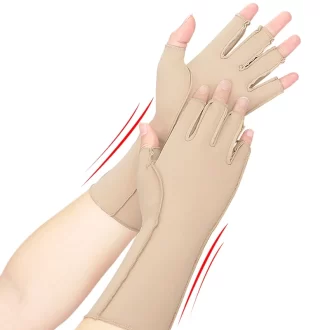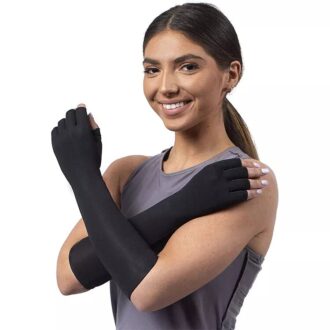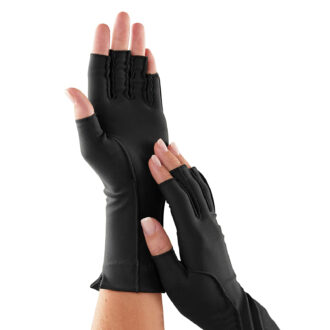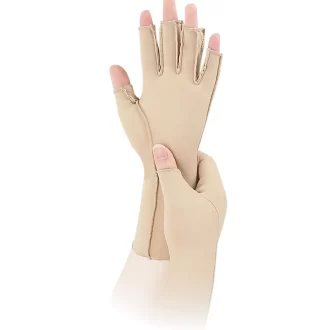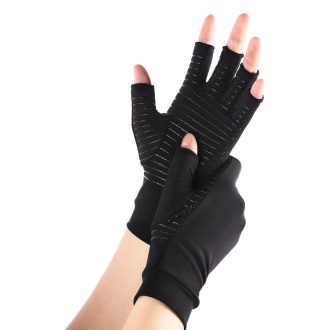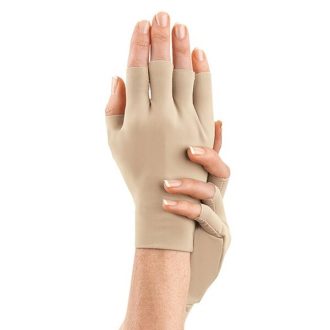No products in the cart.
Typing gloves
Do you suffer from aches and pains in your hands and fingers due to long hours of typing and computer use? You’re not alone. Our hands and fingers were never designed for the repetitive motions and constant stress of modern technology. Typing, clicking, and scrolling can all lead to a range of problems, from simple discomfort to severe conditions like arthritis. Here at NuovaHealth, we understand your pain and we have just the solution to help alleviate it. Our range of typing gloves, including our own branded products and premium options like RevitaFit, offer the support and compression your hands and fingers need. Before we dive into how these gloves can work wonders for you, let’s first explore how typing and computer use can impact your hands.
How Typing Gloves Can Help
Typing gloves can be a game-changer. They offer a unique blend of support, compression, and comfort, designed to help you manage and alleviate the discomfort caused by extensive typing. These gloves are specifically engineered to address the common issues that arise from prolonged computer use.
Support and Stability
One of the main benefits of typing gloves is the support they provide. The gloves are designed to stabilize the joints in your hands and fingers, reducing the strain on muscles and tendons. This is particularly beneficial for people suffering from conditions like carpal tunnel syndrome or repetitive strain injury (RSI). By keeping your joints in a natural position, these gloves can help prevent the micro-injuries that lead to chronic pain.
Compression and Improved Circulation
Compression is another key feature. The gentle pressure exerted by the gloves can enhance blood flow, which is crucial for healing and reducing inflammation. Improved circulation delivers more oxygen and nutrients to the affected areas, speeding up recovery and reducing stiffness. This is especially beneficial for those suffering from arthritis, as better blood flow can help ease the symptoms.
Therapeutic Warmth
Many typing gloves are designed to retain heat, providing therapeutic warmth to your hands and fingers. This warmth can relax tight muscles and improve flexibility, making it easier to type without discomfort. It’s like having a mini-therapy session for your hands every time you type!
Enhanced Grip and Comfort
The materials used in typing gloves can also improve your grip on the keyboard and mouse. This reduces the effort needed to type, further easing the strain on your hands. The gloves are often made from high-quality, breathable materials that wick away moisture and keep your hands comfortable throughout the day.
The Impact of Typing and Computer Use on Hands
Excessive typing and computer use can lead to a variety of injuries and conditions. Here’s an overview of some common issues and how typing gloves can help:
Why Choose Typing Gloves from NuovaHealth?
Why choose NuovaHealth typing gloves? Our products stand out due to their superior craftsmanship and focus on health benefits. We don’t just sell gloves; we provide solutions backed by science.
Expertly Designed
NuovaHealth typing gloves are not just any gloves; they are scientifically proven to provide significant benefits. Expertly designed with the wearer in mind, our range of gloves, which includes both our proprietary line and other top-quality brands, is meticulously crafted to offer optimal support and comfort. Their scientific design ensures that each pair fits snugly, providing just the right amount of compression without restricting movement. This makes them ideal for anyone who spends long hours typing or engaging in repetitive hand tasks. Scientific studies have shown that the precise compression offered by these gloves can reduce hand fatigue, improve circulation, and decrease the risk of repetitive strain injuries.
Carefully Tested & Recommended by Doctors
The gloves from our range go through extensive testing to ensure their effectiveness. They are recommended by doctors and have been shown to alleviate pain and improve hand function. This rigorous testing guarantees that you are getting gloves that work, offering you peace of mind and the assurance that you’re investing in a product that genuinely helps.
Medical-Grade Materials
All of the gloves in our range are crafted from high-quality, medical-grade materials that have been rigorously tested to meet stringent medical standards. This ensures not only their safety and effectiveness but also their exceptional durability. Whether you’re typing away for hours or engaging in other activities, you can trust that our range of gloves will provide long-lasting performance and essential protection for your hands.
Lightweight and Breathable
No one wants to wear gloves that feel bulky or cause your hands to sweat. The gloves in our range are lightweight and breathable, making them comfortable to wear for long periods. The breathable fabric ensures that your hands remain dry, reducing the risk of skin irritation. This is particularly beneficial for those who need to wear them throughout the day.
30-Day Money-Back Guarantee
We are confident in the quality and effectiveness of the typing gloves in our range, which is why we offer a full 30-day money-back guarantee. If you’re not satisfied with the results, simply return the gloves within 30 days for a full refund. This guarantee shows our commitment to your satisfaction and our confidence in the products we offer.
Customer Satisfaction
Don’t just take our word for it—our customers rave about the relief they’ve found with our range of gloves. With hundreds of positive reviews from office workers, avid gamers, and many others, the feedback is overwhelmingly positive. It’s time you experience the same benefits that have made our gloves a popular choice for many.
Get in Touch
If you have any questions or need help picking the right gloves from our range, please don’t hesitate to get in touch. We are more than willing to assist you with any inquiries you might have, ensuring that you find the perfect pair to meet your needs. Your satisfaction is our top priority, and we are here to help you every step of the way.
What Are You Waiting For? Transform Your Typing Experience Now with Ultimate Comfort from NuovaHealth Typing Gloves!
Long hours of typing and computer use don’t have to lead to chronic pain and debilitating conditions. By investing in a pair of NuovaHealth typing gloves, you’re taking an essential step toward safeguarding your hand health. Explore our range below and say goodbye to discomfort and hello to a more comfortable, productive you!
Disclaimer:
At NuovaHealth, your health and well-being are our top priorities. We are dedicated to providing you with high-quality products that genuinely contribute to your comfort and health. Our range of typing gloves, including our own branded products and premium options like RevitaFit, are meticulously crafted from medical-grade materials, expertly designed, and thoroughly tested to ensure their effectiveness. However, it is important to remember that our typing gloves are not a one-size-fits-all solution.
Before using any of our typing gloves, especially if you have underlying health conditions, we strongly advise consulting with a healthcare professional. This is crucial because certain conditions may require specific types of support or may even be aggravated by compression gloves. For example, individuals with severe arthritis, circulation issues, or skin conditions might need tailored medical advice to avoid further complications.
Persistent aches and pains, or injuries to your hands, should be evaluated by a doctor to obtain a proper diagnosis. This step is essential to identify the root cause of your discomfort and to recommend the best course of treatment for you. A comprehensive treatment regime often includes more than just wearing typing gloves. To get the best results, we suggest using a combination of methods to help your recovery and improve your hand health.
Examples of additional treatments include:
- Ergonomic Adjustments: Ensure that your workspace is set up to minimize strain on your hands and fingers. Proper chair height, keyboard placement, and monitor positioning can make a significant difference.
- Hand Exercises: Regularly performing hand and finger exercises can help maintain flexibility and strength, reducing the risk of injury.
- Breaks and Relaxation: Taking frequent breaks from typing and using computers can help prevent overuse injuries. Stretching and relaxing your hands during these breaks can alleviate tension and improve circulation.
- Physical Therapy: For more severe conditions, a physical therapist can provide specialized exercises and treatments tailored to your needs.
- Anti-inflammatory Treatments: Over-the-counter anti-inflammatory medications or prescribed treatments can help manage pain and inflammation.
While our typing gloves are an excellent tool to support your hands, they should be considered as part of a broader, comprehensive approach to hand health. By combining these methods, you can effectively address the underlying issues and promote long-term well-being for your hands.
Thank you for choosing NuovaHealth. We are committed to helping you achieve a healthier and more comfortable typing experience.
Arthritic Gloves By RevitaFit™
- RevitaFit compression gloves steady support for sore, stiff hands: RevitaFit arthritis compression gloves combine gentle warmth with light–mid compression in a slim, fingerless build—so you can type, cook, craft or garden with less stiffness and strain.
- Experience relief and steady support: Light–mid compression (set by the size you choose) can reduce puffiness, ease stiffness and steady your grip, while gentle warmth around key joints makes everyday tasks feel easier.
- Choose your fit: Unisex S/M/L sizes. Measure around your knuckles (MCP line). If you’re between sizes, pick smaller for a firmer feel or larger for comfort. Snug, not painful—no tingling or colour change.
- Fingerless comfort with a smooth interior: Fingerless design keeps your touch precise, and outside seams leave the inside smooth to minimise rubbing over tender knuckles and finger edges.
- Ergonomic movement and steadier pinch: An ergonomic shape supports natural movement, while a reinforced thumb web spreads pinch load at the thumb base for more controlled grip.
- Extended wrist cuff that stays put: Gentle wrist coverage helps the glove stay in place as you grip, carry and reach—without restricting your range of motion.
- Breathable warmth, quick‑dry comfort: A soft, four‑way stretch knit holds soothing warmth without feeling clammy and rebounds to keep its fit. Slim enough to wear under thermal gloves or mittens on colder days for extra comfort and support.
- Built for daily use: Double‑stitched stress points improve day‑to‑day durability at the cuff and between fingers. Easy care to maintain support.
- Recommended uses: Hand osteoarthritis (fingers and thumb base), inflammatory‑arthritis symptoms under medical care, everyday hand swelling, cold‑sensitive hands/Raynaud’s in the hand, mild tendinopathy around the wrist or thumb base, overuse/repetitive‑strain discomfort, and mild hand hypermobility.
- 30‑day reassurance: Try them for 30 days. If they’re not right for you, return them in original condition for a refund under our fair‑use money‑back guarantee.
- Take care of your hands today: Choose your size, pick your preferred feel, and wear them during the tasks you do most to see the difference.
£10.99inc VATRevitaFit™ Long Compression Computer Typing Gloves
- 1x Pair of Long style Compression Computer Typing Gloves designed and expertly crafted by RevitaFit™ using advanced stitched techniques for the best possible durability, support and comfort
- For both Men & Women
- Available in a range of different sizes to fit any hand size & type easily
- Covers your forearms, wrists, hands and fingers for all round support, compression and comfort
- Helps prevent fatigue, stiffness and cramps and spasms in your hands and finger when typing on a computer for long periods of time
- Designed to boost the blood flow in your hands and fingers through compressing and stimulating your blood vessels to keep them expanded and a constant flow of blood flowing through them
- The boost in circulation that these gloves will give you will also help to keep cells oxygenated and prevent the build of of lactic acid in your hands and fingers to prevent aches and pains and fatigue
- Helps improve the way your hands function by supporting the joints, muscles and tendons in your hands and fingers in the right position which will help to reduce the strain and pressure being put on them when you are typing to prevent carpal tunnel syndrome and repetitive strain injuries and reduce wear and tear
- Ideal for people who suffer from Arthritis, Gout, Oedema, Blood Pooling, Poor circulation, Raynaud’s disease, Carpal Tunnel Syndrome, Repetitive strain injuries, Hand cramps, stiffness, numbness and aches and pains
- Features specially designed skin-friendly moisture wicking fabric that absorbs moisture from your skin and quickly dries to help keep your hands dry and fresh whilst the copper infused fibres help eliminate bacteria and odour and helps prevent rubbing and chaffing meaning you can wear these gloves comfortably all day long
- Also ideal for wearing whilst exercising, playing sports or carrying out your daily activities to better protect and soothe aches and pains deep within your forearms, wrists, hands and fingers
- These Gloves include a full 30-day money back guarantee!
£14.99inc VATRevitaFit™ Compression Gloves for typing
- 1x Pair of RevitaFit™ Compression Typing Gloves specially designed to support, compress the joints, ligaments, muscles and bone in your hands whilst you are typing on a computer to prevent stiffness, aches, pain and injuries such as Capral tunnel syndrome and Repetitive strain injury
- For both Men & Women
- Available in a range of different sizes:
- Helps support your hands and fingers in a comfortable position whilst actively improving the way they function to ease strain and pressure off them and prevent pain and injury
- Ideal for stopping your hands and fingers from cramping and seizing up when typing or using a mouse on a computer for long periods of time
- Made from premium fabric with high quality stitching and craftsmanship going into the gloves to ensure an excellent level of durability and support
- Applies soothing compression to your hands and gingers to help stimulate the blood flow in them, drain excess fluid and reduce swelling and inflammation
- The boost in circulation that these gloves will give you will also help to speed up injury recovery and stop fatigue in your hands and fingers by supplying fresh oxygenated blood to them
- Recommended for people suffering from Carpal tunnel syndrome, Repetitive Strain Injury, Rheumatoid Arthritis, Osteoarthritis, Raynaud’s disease, Oedema, Fibromyalgia, Tendonitis, Muscle fatigue, Hand spasms and cramps and Gout!
- The breathable soft and skin friendly fabric helps prevent the gloves from rubbing, chaffing and irritating your skin whilst you are wearing them and the antibacterial and moisture wicking properties of the gloves will also keep your hands and fingers dry, sweat and odour free and feeling fresh and comfortable through out the day
- These Gloves include a full 30-day money back guarantee!
£10.99inc VATMagnetic Infra-red ray Compression Support Gloves for Arthritis
- 1x Pair of Soothing Compression Magnetic Gloves – Ideal for people suffering from Arthritis, Raynaud’s Disease and Carpal Tunnel Syndrome.
- One size fits all.
- For both Men and Women.
- Made from breathable nylon material that will keep your hands dry and sweat free
- Features Infused copper with magnetic and anti-bacterial properties
- Provides soothing compression support that helps improve blood flow to your hands and eases discomfort and pain
- Strategically placed magnets help to soothe aches and pains deep within your finger joints
- Absorbs infra-red rays from sun light and directs these rays to your skin helping to expand your blood vessels to improve circulation and ease symptoms caused by Raynaud’s disease episodes
- Includes full 30 day money back guarantee.
Warning! Please note this item contains Magnets and so it can potentially interfere with pacemakers, defibrillators, and other medical implants that could be affected by magnets. Do not buy this item if you have an implanted medical device, we cannot be held liable for any damage caused wearing this product.£9.99inc VATAnti Arthritis Gloves By RevitaFit™
- Experience Unmatched Relief – Discover unparalleled comfort and support with RevitaFit’s expertly designed anti-arthritis gloves. These gloves provide soothing relief for individuals with Rheumatoid Arthritis, Osteoarthritis, poor circulation, or Carpal Tunnel Syndrome, enhancing daily life.
- Gentle Compression for Better Circulation – Say goodbye to sore, aching hands. RevitaFit gloves apply gentle compression to boost blood flow, reducing joint pain and stiffness. This improved circulation alleviates discomfort and promotes healing, making everyday tasks easier and less painful.
- Enhance Functionality and Mobility – RevitaFit gloves are crafted to position your hands and fingers correctly, enhancing functionality and mobility. By reducing strain on joints, ligaments, and muscles, they help prevent future injuries. Imagine cooking, typing, or gardening with ease once more—an effective way to improve your quality of life.
- Comfortable, Durable, and Easy to Maintain – Made from high-quality, breathable fabric, RevitaFit gloves are soft yet durable. The material’s moisture-wicking and antibacterial properties keep your hands dry and comfortable. Plus, they’re machine washable, allowing you to enjoy their benefits again and again.
- Risk-Free Satisfaction Guarantee – RevitaFit is confident in the quality of their gloves. That’s why they offer a 30-day money-back guarantee if you’re not completely satisfied, giving you peace of mind to try them risk-free.
- Don’t Wait Any Longer – Whether for yourself or a loved one, RevitaFit’s Anti-Arthritis Gloves are the perfect solution for reducing arthritis-related aches and pains. Take the first step toward relief and comfort—your hands deserve it.
£10.99inc VATComputer Gloves for typing
- 1x Pair of Computer Gloves for easing hand and finger, stiffness, fatigue, aches and pains whilst typing on a keyboard
- For Both Men & Women
- Available in sizes: Small (13-17cm), Medium (17-20cm) and Large (20-24cm) measure around the hand for the best fit
- Helps boost the mobility of your hands, reduce stiffness and ease aches and pains
- Supports your hands in a more natural position helping to reduce strain and pressure off key ligaments, tendons, muscles, joints and bones found in your hands and fingers
- Stimulates blood flow and circulation to your hands helping to aid the natural healing process of injured hands, ease muscles fatigue and soreness, and reduce inflammation and swelling
- Provides light compression that massages and soothes your hands whilst you type on the computer
- Ideal for people who suffer from tired aching hands as well as recommended for treating conditions such as Arthritis, Carpal Tunnel Syndrome, Tendonitis, Raynaud’s Disease, Oedema (Swollen hands) and Repetitive strain injuries
- Made from a blend of soft, skin friendly cotton, polyester and spandex material that is soft and skin friendly and wicks moisture away to keep your hands feeling dry and fresh
- Includes a full 30 day money back guarantee if you are not 100% satisfied with your purchase!
£9.99inc VATCopper compression gloves
- 1x pair of Copper Compression Gloves designed to ease aches and pains deep within the hands
- For both Men and Women
- Available in a range of different sizes – For the correct sizing measure around the hand underneath the thumb: (Small) 13cm-17cm, (Medium) 17cm-20cm, (Large) 20-24cm
- Provides soothing and targeted compression ideal for easing pain, reducing stiffness and swelling associated with joint disease and other hand conditions and injuries including Osteoarthritis, Rheumatoid Arthritis, Raynaud’s Disease, Oedema (Swollen hands), Neuropathy, Diabetes, Fibromyalgia, Tendonitis, Carpal Tunnel Syndrome, Sprains and Strains
- Supports your hands in the correct position and improves hand mobility and function
- Designed to boost blood circulation to your hands to aid the natural healing process of injured muscles, ligaments and tendons
- The high copper content provides soothing pain relief and its antibacterial properties help kill bacteria reducing the risk of infection of wounds
- Made from a high quality blend of soft and durable 88% copper nylon and 12% spandex fabric material
- The breathable design and moisture wicking technology helps keep your hands sweat free and dry
- The anti slip grippers have been designed to improved grip and make these gloves ideal for daily wear and carrying out your usual day to day activities.
- Non bulky and perfect for wearing underneath existing gloves for added warmth during the winter months.
- Includes a full 30 day money back guarantee if you are not 100% satisfied with your purchase!
£10.99inc VATCompression Arthritis Gloves
- 2x High Quality Anti Arthritis Compression Gloves (Left and Right hand)
- For both Men & Women
- Ideal for people suffering from Arthritis & Carpal tunnel syndrome
- Soothing compression helps to improve circulation and eases pain and stiffness in the joints
- Designed to support your hands and fingers in the correct position helping relieve pressure and prevent strain from injuring your hands
- Machine washable – use them again and again
- Includes a full 30 day money back guarantee if you are not 100% satisfied with your purchase!
£9.99inc VAT
